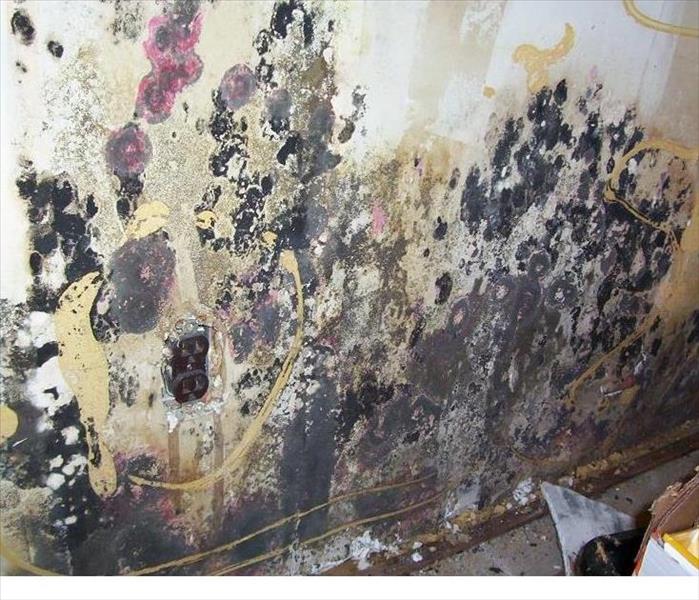7 Ways To Prevent Mold
8/22/2018 (Permalink)
Mold spores love to spread and they do easily. No matter how great you clean you cannot get rid of all mold. Adding to the problem is that mold can grow anywhere--carpet, clothing, food, paper, and in places you can't see like the backside of drywall, areas inside walls around leaking or condensing pipes, and above your home’s ceiling tiles. Here are some ideas:
1. Equip your home with mold-resistant products.
Building a new home or renovating an old one? Use mold-resistant products like mold-resistant drywall or mold-resistant sheetrock, and mold inhibitors for paints. Traditional drywall is composed of a gypsum plaster core pressed between plies of paper. Mold-resistant drywall is paperless — the gypsum core is covered in fiberglass, making the surface highly water-resistant. Moisture-resistant drywall is especially valuable in areas prone to wetness, such as bathrooms, laundry rooms, basements, and kitchens.
Not only is traditional drywall more susceptible to mold than the paperless kind, but it is also difficult to rid of mold, and removal and replacement can be expensive. Mold-resistant gypsum board is also available; the core of the drywall is developed in such a way to prevent moisture absorption, and thus prevent mold growth.
Questions about mold or mildew? We’re experts. Call SERVPRO of Glastonbury/Wethersfield at 860.633.8791
2. Monitor humidity indoors.
The EPA recommends keeping indoor humidity between 30 and 60 percent. You can measure humidity with a moisture meter purchased from your local hardware store. You'll also be able to detect high humidity by simply paying attention to potential problem areas in your home. Telltale signs of excessive humidity include condensation on windows, pipes, and walls. If you notice condensation, dry the surface immediately and address the source of moisture (for example, turn off a humidifier if water appears on the inside of nearby windows).
3. Direct water away from your home.
If the ground around your home isn't sufficiently sloped away from the foundation, water may collect there and seep into your crawlspace or basement.
4. Freshen your fabrics and upholstery.
Avoid sending mold spores into the air and throughout the house by first taking fabric and upholstery that's mobile outside. Brush off as much of the mildew as possible. Then treat these pieces individually as follows.
• Fabric should be laundered in chlorine bleach and hot water. If chlorine bleach is not a safe option for the material, soak it in oxygen bleach and hot water for a half hour, then wash as directed. Take it outside to dry in the sun if possible.
• Upholstery that you can't take outside should be vacuumed first. Replace the vacuum bag or take the canister outside to clean. Then mix 1 cup of ammonia with 1 cup of cool water. (Chlorine bleach and ammonia should never be combined due to the resulting toxic fumes.) Using a clean white cloth, sponge the stains with the ammonia solution. Blot until all the liquid is absorbed. Repeat the process until the stain disappears. To remove the resulting ammonia solution, sponge the area with cold water and blot. Dry thoroughly with a fan or hair dryer set on cool.
Questions about mold or mildew? We’re experts. Call SERVPRO of Glastonbury/Wethersfield at 860.633.8791
5. Clean or repair roof gutters.
A mold problem might be a simple matter of a roof that is leaking because of full or damaged gutters. Have your roof gutters cleaned regularly and inspected for damage. Repair them as necessary, and keep an eye out for water stains after storms that may indicate a leak.
6. Improve air flow in your home.
According to the EPA, as temperatures drop, the air is able to hold less moisture. Without good air flow in your home, that excess moisture may appear on your walls, windows and floors. To increase circulation, open doors between rooms, move furniture away from walls, and open doors to closets that may be colder than the rooms they’re in. Let fresh air in to reduce moisture and keep mold at bay.
7. Keep mold off household plants.
They're beautiful and help keep your indoor air clean — and mold loves them. The moist soil in indoor plants is a perfect breeding ground for mold, which may then spread to other areas of your house. Instead of getting rid of your plants, try adding a bit of Taheebo tea to the water you give to your houseplants. The oil of this tree, which withstands fungi even in rain forests, helps hinder mold growth in plant soil and can be found at natural food stores.
Bonus: Learn your local climate.
Finally, educate yourself on your region's climate — be it the cold and wet Northeast, the hot and wet South, the hot and dry Southwest, or the cold and dry West — and how it responds to moisture. There is no one-size-fits-all solution when it comes to mold prevention. Knowing what works for your climate and your home is an important first step.
Help Is Here
Questions? Call SERVPRO of Glastonbury/Wethersfield to discuss. Call 860.633.8791. We’re the mold, mildew, and water removal service professionals who have saved property and saved money for the owners of flooded basements and water damaged properties. We serve homeowners and business owners in Glastonbury, Marlborough, Portland, Rocky Hill, and Wethersfield.
SERVPRO of Glastonbury/Wethersfield
IICRC Certified
Noemi Garcia
Franchise Owner
Call 860.633.8791
Fax 860.216.2762
24-hour emergency service






 24/7 Emergency Service
24/7 Emergency Service
